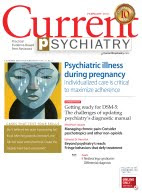Wednesday, April 1, 2009
Worried about high-dose prescribing? Manage risk for you and your patient
Neil S. Kaye, MD, DFAPA
Assistant clinical professor of psychiatry and human behavior, Assistant clinical professor of family medicine, Jefferson Medical College, Philadelphia, PA
Jacqueline M. Melonas, RN, MS, JD
Vice president, risk management, Professional Risk Management Services, Inc., Arlington, VA
Mr. B, age 35, is admitted for the fourth time to the inpatient service with hallucinations and delusions related to chronic schizophrenia. After appropriate attempts to control his symptoms, he has begun to respond to usual treatment with an atypical antipsychotic. He remains a “partial responder,” however, at the maximum FDA-approved dosage listed in the package insert (PI). What do you do next?
Because of this author’s (NSK) dual training in medicine and forensic psychiatry, other clinicians often ask me about patients such as Mr. B. Prescribing for patients who do not respond to standard dosages can create anxiety about going “off-label.” This article describes how to manage potential risk to yourself and your patient by communicating effectively and documenting informed consent.
Read full text (free access)
Comment on this article
Email the editor
Subscribe to:
Post Comments (Atom)


No comments:
Post a Comment